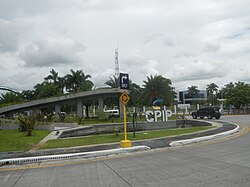The topic of this article may not meet Wikipedia's notability guideline for geographic features .(May 2021) |
This article needs additional citations for verification .(February 2024) |
Calamba Premiere International Park | |
|---|---|
 Calamba Premiere International Park in July 2019 | |
 | |
| Coordinates: 14°11′50″N121°08′00″E / 14.1971°N 121.1332°E | |
| Country | Philippines |
| Region | Calabarzon (Region IV-A) |
| Province | Laguna |
| City | Calamba |
| Barangay | Batino, Barandal and Prinza |
The Calamba Premiere International Park (CPIP) operated by the legal entity Calamba Premiere Realty Corporation as established in 1999, is one of the first industrial parks in the Philippines. It is a comprehensively-planned industrial estate located at Batino, Barandal, and Prinza in Calamba, Laguna and provides a workplace for technology-based, light and medium industries.